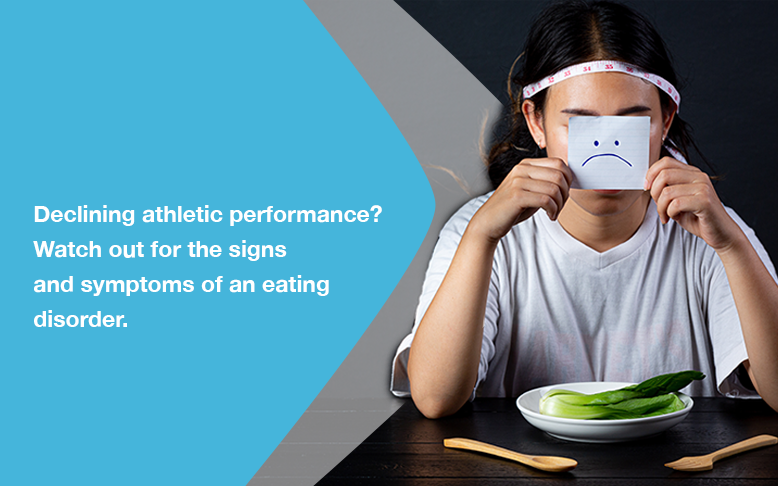Introduction
Eating disorders in athletes are a significant but often overlooked problem that has far-reaching consequences for both performance and health. These psychological conditions can creep into athletes' lives quietly, derailing their pursuit of excellence and jeopardizing their overall health. Eating disorder behaviors in athletes are difficult to detect because they are often glorified regardless of the sport in which they compete. While behaviors like obsessing over food intake, training long and hard hours outside of practice, and fueling the body with "healthy" foods are all praised, these are just a few warning signs that an athlete may be struggling. Various studies have examined the prevalence of eating disorders in different populations of athletes. One study noted that 13.5% of athletes struggle with an eating disorder and up to 45% of women athletes are reported to struggle with disordered eating patterns or full-blown eating disorders.1 By examining the alarming reality of eating disorders among athletes and their impact on performance, physical health, and mental toughness, there can be increased awareness, promotion of early intervention, and creation of a welcoming environment that places a priority on the all-around well-being of athletes.
Eating disorders can significantly impair physical and psychosocial well-being and should not be regarded simply as disorders of eating. Poor nutrient and energy intake can lead to various health complications that affect sports performance and overall well-being, such as dehydration, electrolyte imbalances, amenorrhea, low bone density, reduced muscle protein, and dental problems.4
What are the common types of eating disorders among athletes?
Disordered eating (DE) among athletes exists in a continuum, from optimized nutrition to presence of eating disorders (ED).2 DE behaviors such as meal skipping, compulsive eating, compulsive exercise, or restrictive eating are common in people who do not meet all of the criteria for an ED diagnosis. DE and dieting practices, on the other hand, are known to contribute to the development of ED. Eating disorders, recognized as serious mental health conditions with physical effects, can affect anyone. Feeding and eating-related disorders, as defined in the Diagnostic and Statistical Manual of Mental Disorders (5th edition, DSM-5) by the American Psychiatric Association, include anorexia nervosa, bulimia nervosa, binge eating disorder, other specified feeding and eating disorders (OSFED), and avoidant or restrictive food intake disorder (ARFID).2
Source: Difference between Disordered eating and Eating Disorders https://www.verywellmind.com/difference-between-disordered-eating-and-eating-disorders-5184548
Anorexia nervosa is defined by persistent 'caloric restriction, a fear of weight gain, weight gain-resistance behavior, and a distorted perception of weight or shape.3 Athletes with anorexia nervosa frequently exhibit extreme behaviors to limit their calorie intake such as excessive exercise, strict dieting, or meal-skipping, which results in dramatic weight loss and serious health effects.
Bulimia nervosa, on the other hand, is characterized by recurrent binge eating and inappropriate compensatory behaviors to avoid weight gain.3 Self-induced vomiting, misuse of laxatives or diuretics, excessive exercise, or fasting are examples of compensatory behaviors.
Binge-eating disorder (BED) consists of recurrent episodes of binge eating without compensatory behaviors but with significant distress.3 Athletes suffering from BED frequently consume large amounts of food in a short period of time, demonstrating a lack of control over their eating behavior.
OSFED refers to eating disorders that do not meet the criteria for anorexia, bulimia, or BED. Examples include atypical anorexia nervosa (where weight is not below the typical diagnostic threshold) and purging disorder (purging behaviors without binge eating episodes).
ARFID is similar to anorexia but does not involve distress about body shape or size.2 Previously known as "Selective Eating Disorder”, Avoidant or Restrictive Food Intake Disorder (ARFID) involves extreme limitations in the amount and/or types of food consumed. ARFID as defined by DSM-5 is diagnosed when there's an ongoing eating issue causing nutritional problems and interference with daily life, not due to food scarcity or cultural practices, not aligned with anorexia or bulimia, and not attributable to another condition unless it's more severe and warrants additional attention.3
Why are athletes more likely to develop eating disorders?
Several risk factors contribute to the development of eating disorders among high-performance athletes, including biological, psychological, socio-cultural, and sport-specific factors, as well as gender-based factors and other risk factors like a history of trauma or chronic disease.2 Eating disorders can affect athletes of all genders but may be more apparent in females. Certain sports may also present a higher risk. Athletes, especially those in sports that emphasize weight, appearance, or performance in specific body shapes, can be at a higher risk of developing eating disorders due to a combination of various factors. Athletes in all sports are at risk of DE and ED, but three categories have a higher risk: aesthetically judged sports, gravitational sports, and weight class sports.2 Some other common reasons why athletes may be more susceptible to eating disorders include performance pressures, body image concerns, misinformation and a lack of knowledge about nutrition and body management. Student-athletes also face increased stress and pressure from academic and sports demands.
While not all individuals with DE meet the diagnostic criteria for an ED, those with ED often have DE.3 Unrealistic or distorted views of appearance, body weight, and food are common among individuals with ED, leading to an excessive focus on weight loss and engagement in unhealthy practices such as extreme dieting, vomiting, and excessive exercise. These behaviors put athletes at risk of injury or illness.5
What are the signs of eating disorders among athletes?
While disordered eating (DE) may be a stepping stone or precursor to an eating disorder (ED), not all athletes with DE will progress to a diagnosed ED. However, DE behaviors can still have negative consequences for physical health, mental well-being, and athletic performance. Untreated DE can lead to the development of ED and increase the risk of mood disorders, anxiety, and substance abuse.6 Coaches should be aware of the physical and psychological indicators of ED. Physical signs include frequent dieting or skipping meals, calorie counting, excessive exercise, secretive eating habits, consuming large amounts of food quickly, strict restriction of certain food groups, avoidance of social eating, and trouble focusing. Psychological signs include constant thoughts about food, the belief that weight loss brings happiness, associating thinness with popularity, feeling unworthy of food, denying hunger, experiencing guilt or shame when eating, and feeling a lack of control in life.7
What are the effects of eating disorders on the athlete’s sports performance?
There is a dearth of evidence on the effect of eating disorders and sport performance. In a reported systematic review of ED on sport performance, results revealed conclusive and inconclusive findings. Caloric imbalance, dehydration, hypokalemia, glycogen depletion, increase in circulatory lactate and loss of lean mass resulted to deterioration in sports performance.1
Athletes with ED or DE experienced low energy availability (LEA) meaning an athlete lacks energy to support physiological function after the elimination of the expended energy cost during exercise. Potential effects of LEA on sports performance including glycogen store depletion, electrolyte imbalances and dehydration, loss of lean body mass and fat. Premature reduction in physical, psychological, and mental capacity, including higher circulatory lactate can produce muscular pain, cramps, and/or a reduction in fat free mass. Depleted glycogen store resulted to reduction in muscular strength and aerobic performance.8
Figure 1. Potential Performance Effects of Relative Energy Deficiency in Sport (Adapted from: Mountjoy et al., 2014)9
Eating disorders and subclinical disordered eating behaviors (DEBs) affect energy availability and increase the risk of a health syndrome known as “Relative Energy Deficiency in Sport” or “RED-S”. When an athlete's energy expenditure exceeds energy intake, RED-S develops. This creates an energy deficiency, decreased glycogen stores, decreased muscle strength and endurance, affects psychological and bone health and other health systems.10
What is the course of treatment for an athlete with an eating disorder?
Recognizing and evaluating the problem is crucial for treating an eating disorder. ED is a life-threatening condition, and a non-judgmental approach is essential for effective treatment. A multidisciplinary team, including a sports physician, psychologist, sports dietitian, coach, and the athlete's family, should be involved in managing ED. This collaborative approach addresses the physical, psychological, and emotional aspects. The treatment aims to help athletes understand the relationship between body weight, food, and performance, and a dietitian can create a suitable meal plan. Severe cases may require hospitalization and round-the-clock monitoring.
Athletes with ED should be evaluated before returning to play, taking into account their current health status and the risks associated with their sport.
Prevention efforts should focus on educating coaches, athletes, athletic administrators, and parents about proper nutrition for performance rather than body weight. Understanding the health consequences of unhealthy eating behaviors and promoting lifelong health should be the primary goals.11
In summary, eating disorders significantly affect athletes' sports performance, overall health, and well-being. A multidisciplinary approach involving proper assessment and treatment is necessary. Early recognition of signs and symptoms, along with education on the health consequences of unhealthy eating practices and proper nutrition, plays a crucial role in prevention.
Message to Nutritionist-Dietitians:
A nutritionist-dietitian (ND) plays a vital role in supporting athletes with eating disorders. Working as part of a multi-disciplinary team that includes other healthcare professionals, a nutritionist-dietitian can help with the following:
- Assessment and Individualized Meal Plans: An RND can conduct a comprehensive assessment of the athlete's nutritional needs, health status, and eating behaviors. And develop personalized meal plans that address the athlete's specific dietary requirements.
- Education and Nutritional Guidance: An RND can provide education about proper nutrition, debunk myths, and promote a balanced approach to food. They can offer guidance on portion sizes, food choices, and the importance of adequate energy and nutrient intake for optimal performance and recovery.
- Normalize Eating Patterns: An RND can help normalize eating behaviors by establishing regular meal and snack times, encouraging balanced meals, and promoting a healthy relationship with food.
- Monitoring and Support: Regular monitoring and check-ins with the RND can help track progress, address challenges, and provide ongoing support. This includes addressing any concerns or questions the athlete may have, offering guidance on nutrition-related matters, and ensuring the meal plan is being followed appropriately.
Relapse Prevention and Long-Term Support: An RND can assist in developing strategies to prevent relapse and provide ongoing support in maintaining a healthy relationship with food and body image. They can help athletes establish sustainable eating habits that promote both performance and overall well-being.


 Karen Leslie L. Pineda , RND, MSPH
Karen Leslie L. Pineda , RND, MSPH









No comments here yet.